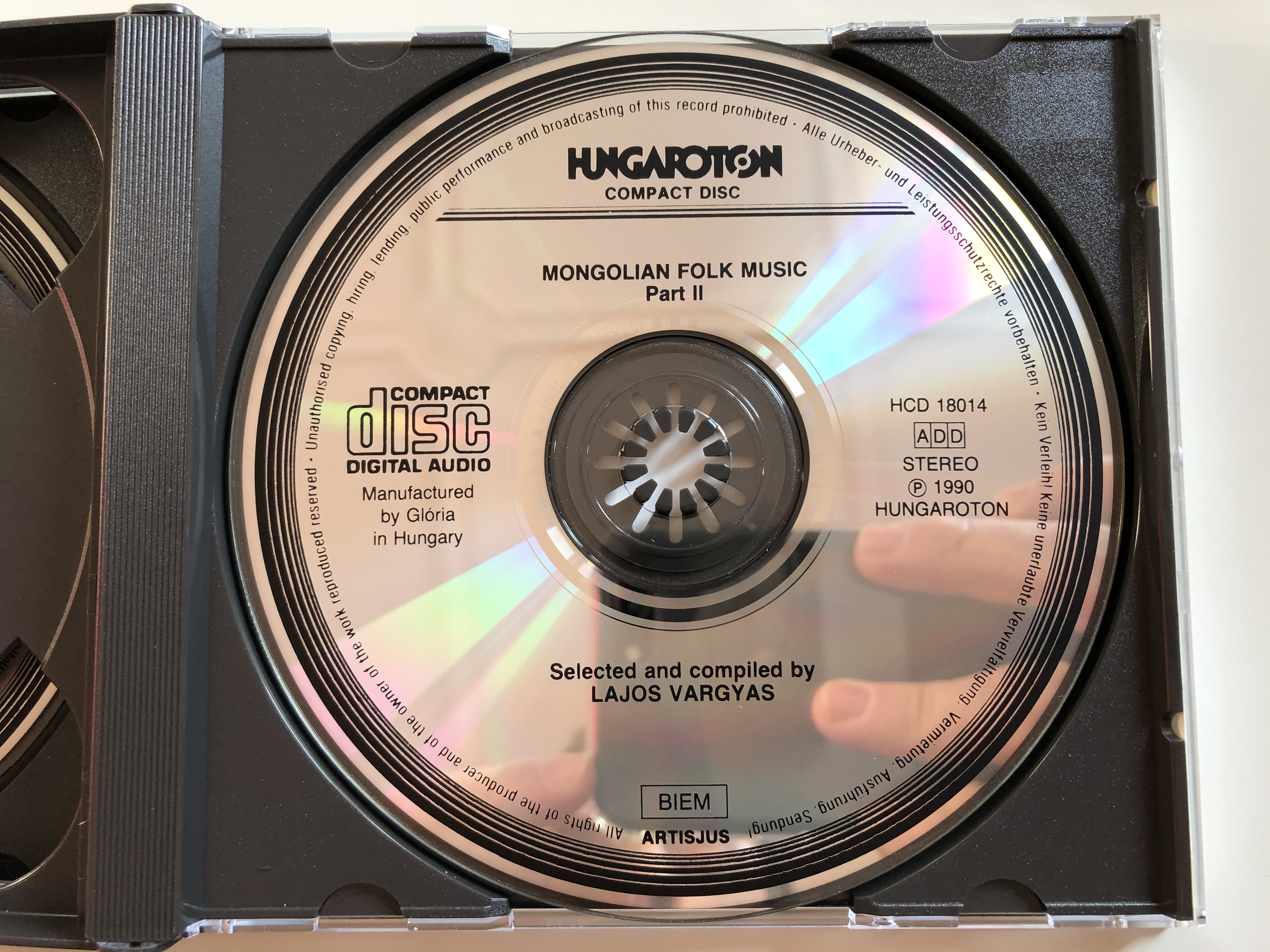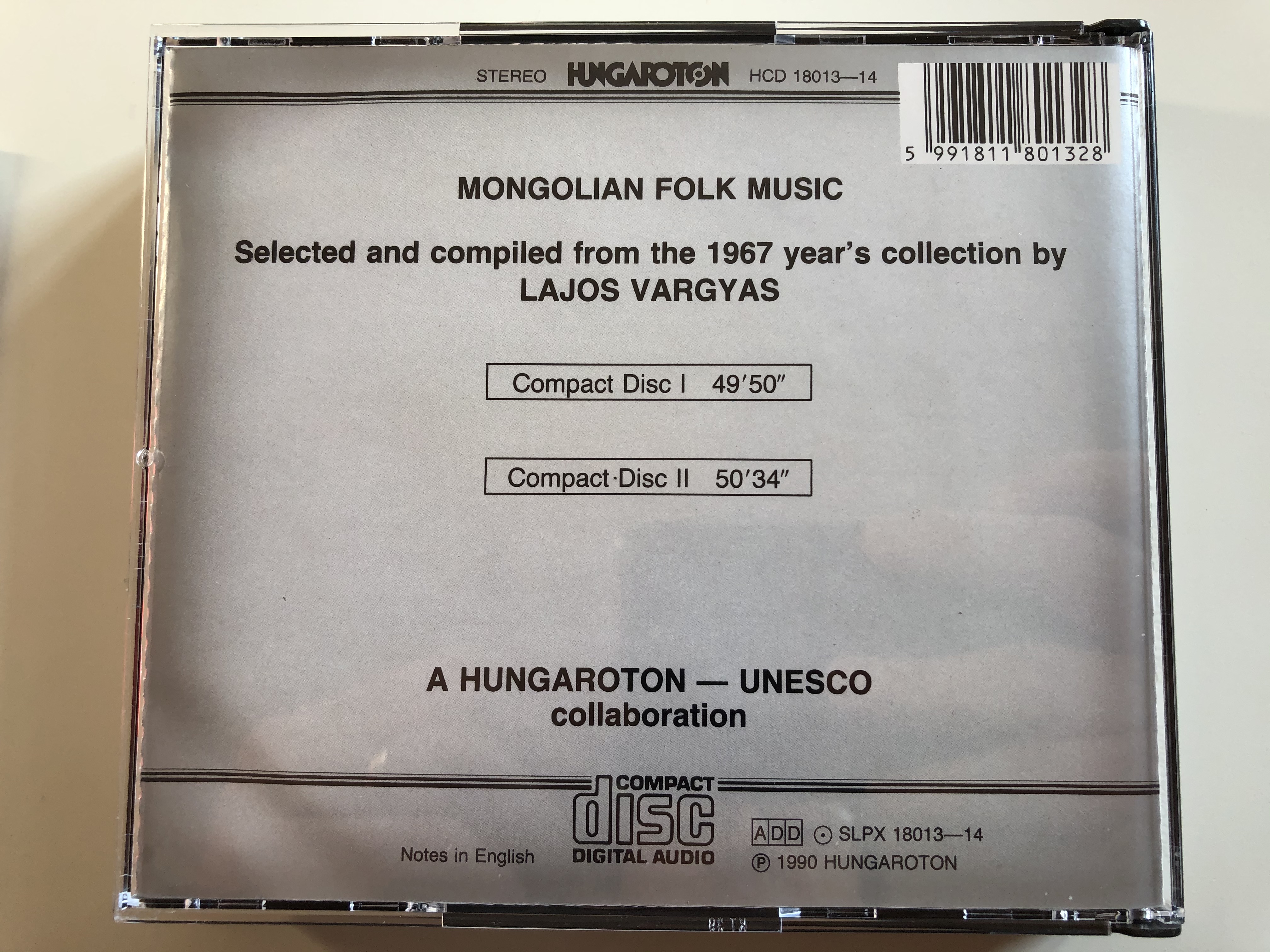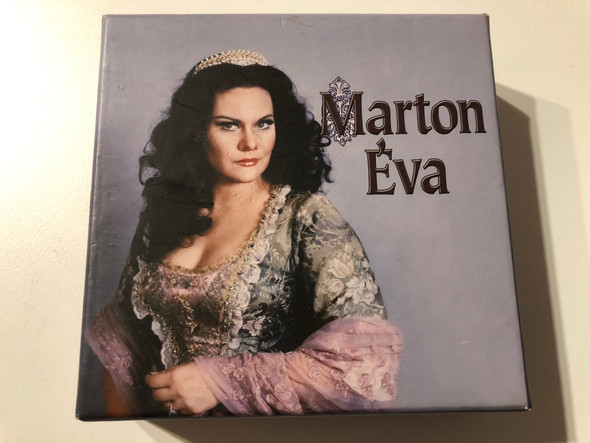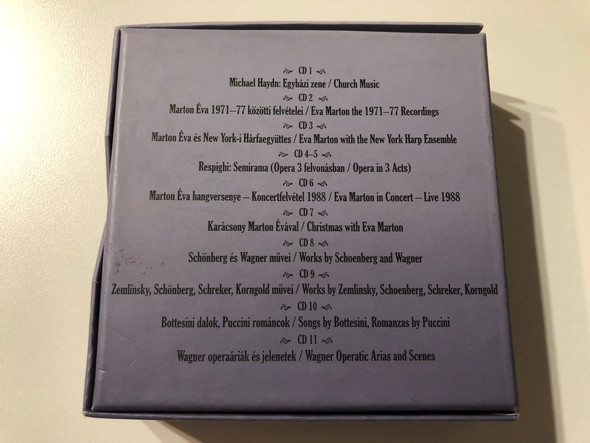Description
Mongolian Folk Music / A Hungaroton-Unesco collaboration / Hungaroton 2x Audio CD Box Set 1990 Stereo / HCD18013-14
UPC 5991811801328
Total time: 49:50 (cd1); 50:34 (cd2)
Originally released on Hungaroton SLPX 18013-14
℗ 1990 HUNGAROTON Notes in English
Tracklist:
| 1-1 | Story Of The Origin Of The Marinhur
Performer, Morinhoor – Dagiranc |
9:26 |
| 1-2 | Praise Song (Magdal) About An Archer In A Tournament
Performer – Dorzhdagva |
2:14 |
| 1-3 | Heroic Song (Magdal) About The Winner Of The Archery Tournament
Performer – Dorzhdagva |
2:38 |
| 1-4; 1-5 | "Zamba Tiv" - 'Long Song'
Performer, Morinhoor – Zhamyan |
6:30 |
| 1-6 | Jew's Harp Song (Ho‑Mi)
Performer – Bori |
0:54 |
| 1-7 | "Dadaj Gerech"
Performer, Yangqin [Yochen] – Dorzhdagva |
0:33 |
| 1-8 | "Hergen" - 'Long Song'
Performer – SuglegmaPerformer, Morinhoor – Ceden |
2:46 |
| 1-9 | "Zergen Tiyn Sil" - 'Long Song'
Performer – SuglegmaPerformer, Morinhoor – Ceden |
2:23 |
| 1-10 | "Uzesgelen Ua"
Performer [Sudrag] – Dazhdulam |
1:38 |
| 1-11 | "Handarma" (Song About A Girl)
Performer [Sudrag] – Dazhdulam |
2:22 |
| 1-12 | "Suenserlen Harandah Ul" (Song About The Nature)
Performer [Sudrag] – Dazhdulam |
2:28 |
| 1-13 | "Urt Sajham Huren" (East Mongolian 'Long Song')
Performer – Dorzhdagva, Performer, Morinhoor – Boyan |
3:51 |
| 1-14 | "Hojer Bor" ('Long Song')
Performer – Dorzhdagva, Performer, Morinhoor – Boyan |
3:26 |
| 1-15 | Jew's Harp Song (Ho-Mi)
Performer – Bori |
1:40 |
| 1-16 | "Sigsirgin Ay" (In Praise Of The Horse)
Performer [Sudrag], Yangqin [Yochen] – Nansalma |
0:40 |
| 1-17 | "Ondor-Sayhan Bor" ('Long Song')
Performer – Dorzh‑suren |
5:16 |
| 2-1 | Praise Song Of The Gobi (Magdal)
Performer – Dagiranc |
8:12 |
| 2-2 | Bor Bor Byalzuhay ('Long Song')
Performer – Dorzhdagva |
2:25 |
| 2-3 | "Durtmal Sayham" (West Mongolian 'Long Song')
Performer – Dorzhdagva, Performer, Morinhoor – Boyan |
4:20 |
| 2-4 | Onchin Cagan Batcho ('Long Song')
Performer [Limba] – Dorzh |
1:44 |
| 2-5 | "Zambu Tiviyn Nar" ('Long Song')
Performer – Norovbancad, Performer, Morinhoor – Batbayar |
3:20 |
| 2-6 | "Urhan Hongor" ('Long Song')
Performer – Norovbancad, Performer, Morinhoor – Batbayar |
2:39 |
| 2-7 | "Hoyer Bor" ('Long Song')
Performer – Lahmzhav, Zhanzanchoi |
2:38 |
| 2-8 | "Uzelen Gua"
Performer [Hocher] – Masuren |
0:40 |
| 2-9; 2-10 |
"Harlsan Hagd" (Darhat Song)
Performer – Nadmid, Performer, Morinhoor – Zhanzanchoi |
2:38 |
| 2-11 | "Bieleg" (Music Of The Shoulder Dance)
Performer [Sudrag] – Bazarragcha |
1:43 |
| 2-12 | "Uyeldur" (Music Of The Arm-Hand Dance)
Performer [Sudrag] – Bazarragcha |
1:37 |
| 2-13 | Dance Melody Performed On The Sudrag
Performer [Sudrag] – Bazarragcha |
2:30 |
| 2-14 | "Setert" (South Mongolian 'Long Song' From Borzhigen)
Performer – Dorzhdagva, Performer, Morinhoor – Boyan |
5:06 |
| 2-15 | "Sumen Delt"
Performer, Yangqin [Yochen] – Dasdeleg |
1:17 |
| 2-16 | "Bayan Sun"
Performer, Yangqin [Yochen] – Dasdeleg |
1:29 |
| 2-17 | "Har Deltei Halyun"
Performer – Bazuh |
4:45 |
| 2-18 | "Gandan Ulun Ceceg"
Performer [Yetah] – Balchinsuren, Cerendolgor, Dolgor, Enhtusin, Gadima, Nadmid, Nansalma, Zhagirzurem |
2:19 |
- Compiled By – Lajos Vargyas
- Design – Hungaroton
- Engineer [Balance] – Attila Fülöp
- Recording Supervisor – Dóra Antal
- Written-By – Traditional
Performers:
Madame Balchinsuren, 28, yetah
Batbayar, 32, born in Suhebator, marinhur
Madame Bazarragicha, 45, born in Ulanbator, sudrag
Bazuh, 39, Dorbot tribe, born in Ird Aymak, singer
Boyan, 46, born in Urhangai, marinhur
Bori, 23, singer (Jew's harp song) (sadly no mention of where he come from!)
Ceden, 45, born in Bayanhongor, marinhur
Madame Cerendolgor, 21, yetah
Dagiranc, 36, born in Dund Gov, accompanying himself on the marinhur
Madame Dasdeleg, 71, born in Seleng Aymak, yochen
Madame Dazhclulam, 40, born in Touv Aymak, sudrag
Dorzh, 50, born in Dorno Gov, limba
Dorzhdagva, 63, born in Dun Gov, singer, retired folk artist of merit
Dorzh‑suren, 48, born in Zavhan Aymak, singer
Madame Dolgor, 39, yetah
Madame Dozhdava, 28, born in Zavhan Aymak, yochen
Miss Enhtusin, 18, yetah
Madame Gadima, 21, yetah
Lhamzhav, 38, born in Za0an Aymak, singer
Madame Masuren, 40, born in Choybalsan, hocher
Madame Nadmid, 30, Darhat tribe, born in Hovsgol Aymak, singer, yetah
Madame Nansalma, 24, born in Dund Gov, singer, yetah
Madame Norovbanzad, 35, born in Dund Gov, singer
Madame Suglegma, 34, born in Arhanchai, singer
Madame Zhagirzurem, 34, yetah Z1ramyan, 46, born in Eastern Mongolia, marinhur
Zhanzanchoi, 24, born in Gov Aymak, marinhur
A selection sufficient for two recordings is not enough to present Mongolian folk music in all its variety, or to give an idea of all its instruments and types of vocal music as well as differences due to region dialects. All this makes Mongolian folk music extraordinarily rich in spite of the fact that it is almost entirely made up of pentatonic music. There are so many variations of vocal techniques, however, including highly unique types of singing, that even a short illustration will surprise a listener accustomed to Western music.
Old lyrical melodies and certain ritual‑like songs are performed with characteristic ornamentation, glissandos, trills and tremolos, which are strongly reminiscent of instrumental sound effects. The most surprising element, however, is the wide vocal range of the songs. Falsetto singing is extremely wide‑spread, and used with strong volume, thus enabling an experienced singer to greatly expand his vocal register. At a certain point the broad melodies are continued one octave higher, extending the melodic line to unbelievable heights. The vocal range of their most famous singer, Dorzhdagva, extends over three octaves, from A to a", as shown in the selections on the discs (I/2‑3, 13‑14, II/2‑3, II/14). Mainly the so‑called long songs" are sung in this fashion. Another peculiarity in the performance of these songs is that the text, sometimes even certain words are broken with meaningless syllables which serve to heighten vocal technique and tonal colour. (This custom is also known in the Balcans). Moreover, they have a type of song, which has no text at all, and is performed throughout with such meaningless syllables (I/2‑3). In other features too, the performing style of these pieces is identical with that of the long songs".
In the women's 1ong songs", the wide vocal range used by the men is missing (retaining the high notes but lacking the deepest register), nonetheless, the vocal technique is just as demanding. In the highest registers their vibratos and tremolos bear witness to a highly developed vocal technique on the same level (I/8‑‑9, II15‑6, II/9‑10).
To expand the vocal range and to develop a unique vocal technique, this in itself is no ordinary accomplishment. Mongolian folk music, however, goes beyond this and overcomes the natural limitations of the human voice. They have developed a technique whereby one person can sing in two voices at the same time. Actually, the one of these is a single prolonged droning fundamental tone above which a flutelike melody is sounded in a high register. Even so, two voices are heard simultaneously from the same throat! These sounds were learned from the Jew's harp which in essence is an instrument producing a droning fundamental tone when the small vibrating metal tongue is held to the lips, and whose overtones are produced by altering the shape of the oral cavity. The Mongolian, however, can produce the same effect without the instrument by tensing their vocal chords and pressing air through them with great force. This gives the instrument‑like effect of a fundamental note rich in overtones, which can then be heard according to the different positions of the mouth cavity. This vocal production forces the diaphragm, demanding at the same time special use of the throat and the mouth, and all this has to be learnt separately. Not everyone can acquire this talent, but it is still fairly common among male singers, especially in Eastern Mongolia. And what is even more incredible, there are some men who can produce this wordless, almost supernatural whistling melody while riding on horseback (I/6, 15).
There are other accomplishments resulting exquisite artistic experiences, which do not so much demand physical strength as great intellectual concentration. Among the different types of epics, there are vocal sagas and praise songs when the singer himself provides the accompaniment, moreover, improvising and varying text, melody and accompaniment alike. That is, he produces three kinds of improvisations simultaneously. Naturally, not all these elements are born during a given performance. The outlines and style of the melody and the accompaniment as well as various points in the text and the content of the saga have come down through history. But it is the singer who on the basis of this rough framework, lends form to the material, on the spur of the moment.
The content of the saga (I/1) is briefly the following: a hero has a winged horse. When he calls the animal, the performer imitates the sound of the horse's neighing and hoof‑beats on his instrument, either by beating or sliding the bow on the strings. The horse and his master fall asleep. His enemy cuts off the horse's wings, thus killing it. The hero mourns for his horse, and this lament, peculiarly enough, is not performed in song but in an instrumental interlude in which, after the pure pentatonic melody, chromatic intervals are suddenly heard. Finally, he makes a musical instrument out of the horse's hide, mane and head the very first marinhur. That is why there is a horse's head carved at the end of the marinhur's fingerboard, just as in the case of many Hungarian zithers. The saga's melody is a type familiar in many parts of the world, it can be found in the Middle East, in the recitation of Catholic psalms as well as in one type of Hungarian folksong now sinking into oblivion. In Mongolian music, however, it contains freer variations and sweeping declamatory rhythm.
The same singer also performs a praise song about the Gobi (II/1). This is a song in verse strophes but still possessing wide opportunity for variation and improvisation. When singing about the girls' dance, the performer beats a dance rhythm with his bow as an accompaniment. The marinhur is the most wide‑spread instrument in Mongolia, and is usually used for vocal accompaniment. The story of its origin shows how deeply it is rooted in Mongolian folklore. It is a cello‑like instrument with two strings and a trapezoid body, which is held between the knees, supported on the ground, as in the case of the Western instrument. Its tone, and especially its glissandos and tremolos virtually reproduce the sound of vocal ornamentation, equally evident as accompaniment when it imitates vocal melody (I/8‑9, 13‑14, II/3, 5‑7, 9‑10, 14), and in solo instrumental performance (I/4‑5).
In addition, there are several other instruments in common use. In these recordings you will hear zither‑like yetah which has the size and tone of a harp (II/18); the limba, a cross-flute (II/4); a three string plugged instrument, the sudrag (I/10‑12, II/11‑13); the hocher, a small two‑stringed instrument with a cup shaped resonating body (II/8); the yochen, the twin of the Hungarian cimbalom (I17, II/16); and finally an ensemble composed of a yihor and a talhengreg (I/16), a large marinhur used as a bass and a castanet like rattle, these but in ensembles.
Besides these a number of other instruments are known which contemporary Mongolian folk music inherited partly from secular and partly from religious sources. There are also new types of singing which are actually the most popular today. Among them can be found works by well‑known composers, which are performed in various programmes mostly by ensembles or outstanding soloists. On these occasions they are accompanied by new type of instrumental ensembles. Some of the selections give a taste of these highly popular songs (I/16, II/18), the latter included in order to give an idea of the sound of the yetah.
The performers on these recordings were all found in Ulan Bator, the capital of Mongolia. This city differs from its counterparts the world over in that it offers as many opportunities for an acquaintance with folk music as any other region in the country. Indeed, perhaps more. The Mongolian cherish their musical traditions, and whenever an exceptionally gifted singer or instrumentalist is found in the provinces, he is sent to the capital either to teach traditional styles in the state music school, or to entertain the public in operatic concerts and other programmes. Thus, in Ulan Bator itself one can become familiar with the traditions of the whole country and from the very best performers.
One of the most outstanding among them is the singer Dorzhdagva, a retired "artist of merit". Others include Dagiranc, a singer of epics and Zhamyan, teacher of the marinhur at the music school. We do not wish to create the impression however, that Mongolian folk music is being perpetuated only by these exceptional singers and instrumentalists. In order to illustrate how deeply rooted the styles they represent are in the daily musical life of the average Mongolian, we have recorded traditional songs, among them a 1ong song", by such performers (I/17, II/17). You will notice that they have the same style, even if the wide range, the use of the falsetto is lacking.
We also wished to illustrate tribal differences and musical dialects. It was for this reason that we recorded Darhat and Dorbot songs. Where no mention is made of origin, the selections refer to Halha Mongolians. The selections on these recordings will surely suffice to convince the listener of the unique musical traditions preserved throughout their long history by these people living in the mountains of Central Asia, and also of the high artistic achievements a traditional folk culture is capable of at its best.





































